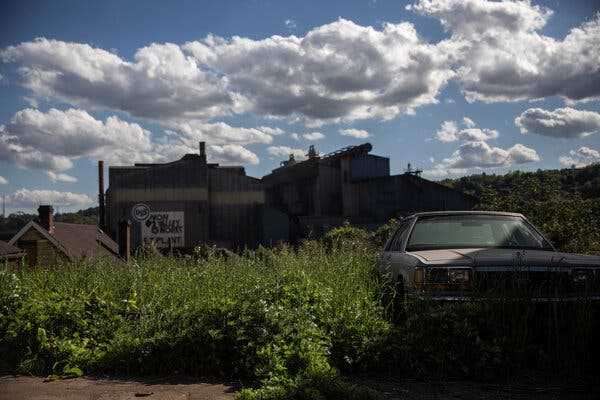The party can ill afford to continue bleeding working-class support in Midwestern states. A new report explores how “progressive populism” could offer a way forward.
-
Send any friend a story
As a subscriber, you have 10 gift articles to give each month. Anyone can read what you share.
Give this article
- Read in app
This article is part of our Midterms 2022 Daily Briefing

The Edgar Thomson steel factory in Braddock, Pa., the city where Lt. Gov. John Fetterman, who is now Democrats’ Senate nominee in the state, lives and formerly served as mayor.
Should Democrats bother competing in the struggling factory towns of the Midwest?
A report to be released on Tuesday answers this question with an emphatic “yes.” But the fact that it is being asked at all speaks to the Democratic Party’s still-unresolved challenge of how to win back the more than 2.6 million voters it has lost in places like Ottumwa, Iowa, and Scranton, Pa., since 2012.
More than five years after Donald Trump galvanized the white working class in America’s fading industrial heartland, Democrats are still trying to understand what happened, and debating whether they should scrounge elsewhere for votes. Should they try to run up the electoral score in urban areas and inner-ring suburbs instead?
Basic electoral math suggests that they have little choice: It would be exceedingly difficult for Democrats to win a governing majority without holding onto their “blue wall” in the Midwest, and continued erosion in smaller communities might make that impossible in the near future.
In this year’s midterms, Democrats are trying to win open Senate seats in Ohio and Pennsylvania, while hoping they can somehow oust Republican incumbents in Iowa and Wisconsin — all states that are dotted with places that have been hurt by the effects of global economic and technological change over the last few decades.
But there’s more at stake than just who wields political power.
“If fascism and authoritarianism continue to rise in this country,” the authors wrote, “it will be because more of the voters in the small and midsized counties of the manufacturing belt fuel its advance.”
An economic slide and political shift
In Iowa, which holds its primaries on Tuesday, the Democratic Party has all but given up.
Trump won the state by more than eight percentage points in the 2020 presidential election, and this year’s midterms augur more misery for Democrats. They hold just one of Iowa’s four congressional seats, and a vanishing number of major statewide offices.
Jasper County, just east of Des Moines, is a prime example of the typical factory town arc.
The county was once the center of the American washing-machine industry, but after the closure of a Maytag plant in 2007, unemployment soared to 10 percent, the highest in the state. Barack Obama won the county with 53 percent of the vote in 2008. But 12 years later, Joe Biden lost it to Trump by 22 points.
Iowa could offer but a glimpse of the future of an entire region that is trending Republican, the new report warns.
Issued by a nonprofit group called American Family Voices, it was written primarily by Mike Lux, a Democratic strategist and Biden ally with roots in the region. It builds on research that was published last fall and highlighted by my colleague Jonathan Martin at the time. The study used polls, focus groups and several hundred interviews and meetings with local officials, political operatives and activists, as well as a deep dive into voter file and census data.
ImageA map included in a report by American Family Voices identifies counties where Democrats can look to regain voters in the Upper Midwest.Credit…American Family Voices
The authors have emerged with a richer set of findings to recommend “a messaging and organizing path forward” for the Democratic Party in the 10 states, 565 counties and nearly 55 million voters they studied.
The polling, which was conducted by Lake Research Partners, shows a population buffeted by the rising cost of living and suffering from health-related crises. A majority, for instance, said they or a family member had a chronic health condition. Majorities also said they had personally struggled with disabilities, job loss, mental health problems or addiction.
The political challenge Democrats face in these communities is stark. The Democratic share of the electorate in so-called factory-town counties shrank from 33 percent to 24 percent from 2012 to 2020, according to TargetSmart, a Democratic data firm that was hired to work on the project, while the Republican share ballooned to more than 51 percent during the same period, from 40 percent.
Voters in this “factory towns” demographic, which still makes up nearly half of the electorate in those states, often view Democrats as too weak to enact their economic agenda, and are cynical about politicians’ ability to help them in general.
‘Progressive populism’
The report contains nine recommendations, which can be boiled down to a call for “progressive populism” to counter the frustration and economic dislocation many of these voters feel about politics.
Lux, who spent much of the last year immersed in the study, said in an interview that “probably the No. 1 surprise to me is how desperate people are for community.”
A former labor organizer, Lux said he came away from his conversations convinced that there was an untapped “hunger” in factory towns to talk about political issues and “get through some of the anger and vitriol into a more balanced conversation.”
He recommends that the Democratic Party, labor unions and progressive activists focus on engaging the pool of voters in the middle who are repulsed by extremism, and are not convinced that the Republican Party has their economic interests in mind.
“This is a challenging mission, given that the level of cynicism and disaffection from mainstream politics runs deep,” Lux acknowledges in the report.
But with the right amount of “old-fashioned community building,” he argues, voters in factory towns “could form a voting bloc that could become a cornerstone for a revival of the progressive movement.”
Image
What to read
-
While Democrats everywhere are deeply worried about a range of political warning signs ahead of the midterms, they have a particular reason for alarm in California, Katie Glueck writes: skyrocketing gas prices.
-
Big-city mayors are furious about the recent spate of mass shootings, but while they often have authority over police departments and social service programs, they say they are largely powerless to enact the gun control measures that many see as necessary to prevent more tragedies. Mitch Smith has the story.
-
Next week, Adam Liptak writes, the Supreme Court may hear the “800-pound gorilla” of election law cases. It concerns a legal theory that would radically reshape how federal elections are conducted by greatly expanding state legislatures’ power to set election rules at odds with state constitutions and to draw congressional maps warped by partisan gerrymandering.
Image
how they run
ImageRobert Garcia, the mayor of Long Beach, Calif., speaking during a protest against police brutality in the weeks after the killing of George Floyd in 2020.Credit…Ashley Landis/Associated Press
Long Beach’s mayor aims to head to Washington

By Leah Askarinam
The mayor of the Southern California city of Long Beach, who made national headlines for his leadership during the pandemic, has emerged as the front-runner for an open congressional seat that Democrats are expected to win in November.
The mayor, Robert Garcia, was the first Latino and first openly gay person to lead Long Beach.
He was one of 17 speakers during the 2020 Democratic National Convention’s keynote address, and appeared in the news throughout the pandemic to urge safety precautions after his mother and stepfather died of Covid-19. Later, he opened the Long Beach Convention Center to shelter undocumented children who had arrived at the southern border.
In Tuesday’s primary election, Garcia has the backing of Gov. Gavin Newsom and multiple members of California’s congressional delegation.
“The issues that existed before the pandemic exist today, but they’re just larger,” Garcia told our colleague Jill Cowan in 2020. “You think about issues around income inequality and homelessness, the housing crisis that exists here in California, climate change — those are all huge.”
Sara Sadhwani, an assistant professor of politics at Pomona College who is a member of California’s redistricting commission and who said she wasn’t publicly supporting a candidate, said that Los Angeles frequently looked to Long Beach as a model for successful policies.
“It seems like his leadership would be both progressive and pragmatic,” Sadhwani said.
Garcia faces several Democratic challengers, the most prominent being Cristina Garcia, who is not related to him.
A member of the State Assembly representing southern Los Angeles County, Cristina Garcia has built a reputation for championing policies to protect and support women. She sponsored legislation exempting pads and tampons from sales taxes and, as head of the Legislative Women’s Caucus, was a leader in California’s #MeToo movement.
Her reputation took a hit in 2018, however, when Politico reported that a former staff member had accused her of groping him; he filed a lawsuit against her and the Assembly arguing that he had been mistreated because he was a man. In a radio interview for KQED, Garcia said she had “never assaulted anyone.”
Around the same time, she was also accused of having made anti-Asian and homophobic comments. She denied that she had intentionally used insulting language.
Her campaign did not respond to requests for comment.
Image
— Blake & Leah
Is there anything you think we’re missing? Anything you want to see more of? We’d love to hear from you. Email us at [email protected].
Source: nytimes.com



